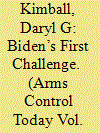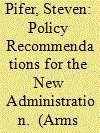| Srl | Item |
| 1 |
ID:
176620


|
|
|
|
|
| Summary/Abstract |
Until the Trump era, every U.S. president since John Kennedy has successfully concluded at least one agreement with the Soviet Union, or later Russia, to reduce the dangers posed by nuclear weapons to the United States and the world.
|
|
|
|
|
|
|
|
|
|
|
|
|
|
|
|
| 2 |
ID:
176623


|
|
|
|
|
| Summary/Abstract |
The UN General Assembly’s first resolution, passed 75 years ago on January 24, 1946, looked to “deal with the problems raised by the discovery of atomic energy.” Specifically, Resolution 1(I) created the UN Atomic Energy Commission (UNAEC) and charged it with making proposals for “the elimination from national armaments of atomic weapons” and the use of atomic energy “only for peaceful purposes.”
|
|
|
|
|
|
|
|
|
|
|
|
|
|
|
|
| 3 |
ID:
176621


|
|
|
|
|
| Summary/Abstract |
The 46th president of the United States, Joseph R. Biden, enters office with a clear commitment to and substantial experience with arms control, nonproliferation, and disarmament that date back to his early days in the Senate.
|
|
|
|
|
|
|
|
|
|
|
|
|
|
|
|
| 4 |
ID:
176622


|
|
|
|
|
| Summary/Abstract |
Since the nuclear Nonproliferation Treaty (NPT) entered into force on March 5, 1970, states-parties to the treaty have gathered every five years to assess implementation of and compliance with the treaty and to seek agreement on steps to advance common goals and objectives related to the three pillars of the treaty: nonproliferation, peaceful uses of nuclear energy, and disarmament.
|
|
|
|
|
|
|
|
|
|
|
|
|
|
|
|
| 5 |
ID:
176624


|
|
|
|
|
| Summary/Abstract |
The world that Vice President Biden would be inheriting goes a long way to telling you the direction of the foreign policy we pursue in office. We are facing the most challenging and complex international landscape and international security landscape, certainly in decades, if not longer.
|
|
|
|
|
|
|
|
|
|
|
|
|
|
|
|